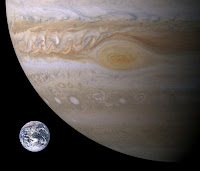Last month we started a tour of the solar system with the inner planets Mercury, Venus, Earth, and Mars. Let's continue that tour with the solar system's outer planets.
Before we continue our tour, the asteroid belt, which lies between the inner and outer solar system, must be acknowledged.
The asteroid belt is essentially a large zone filled with millions upon millions of space rocks, called asteroids. This belt is an interesting place and will possibly be the site of a future "gold rush." In one small asteroid (a kilometre or two across) there could be tens of trillions of dollars worth of precious metals and iron.
Unlike in movies and video games, navigating through the asteroid belt is fairly easy. The belt is so large that the asteroids are spaced many kilometres apart and are easy to avoid.
Now that we've safely navigated the asteroid belt we encounter Jupiter, the king of the planets. This huge planet is eleven Earths wide and has a mass 320 times that of Earth (see size comparison in the below image).
Jupiter has cyclones in its atmosphere that are so energetic they make Earth's hurricanes seem like a gentle breeze. One of those cyclones has been raging across the planet for 400 years and is three times the size of the Earth!
Jupiter also has four large moons, each of which are larger than our moon. These moons are Io, Europa, Ganymede, and Callisto.
The largest of these is Ganymede, so large that it is even larger than the planet Mercury. It may contain an ocean under its thick icy crust.
Europa is another moon with an ocean under its icy crust. This moon will hopefully be visited by a submarine mission to explore its oceans in a few decades. Maybe a Europan fish or eel will swim by the camera. Even a simple microbe would be one of the biggest scientific discoveries ever.
The next planet outwards from the Sun is the planet Saturn (image at left). Saturn features a great set of rings which encircle the planet. These rings are made of tiny chunks of ice and rock.
One of Saturn's moons is larger than Mercury and even has an atmosphere ten times thicker than Earth's. Instead of water raining from the skies, it rains liquid methane at -180°C.
Before we have to put on a tuque, let's move on to the planet Uranus (image below Saturn).
This planet lives up to its gassy giant status with significant amounts of methane in its atmosphere. Although it is commonly made fun of because of its name, it is a very interesting pale blue world which needs to be explored up close.
Most of Uranus' moons are named after characters from Shakespeare's writings. One of the moons, Miranda, is extremely bizarre. Miranda appears to be a heap of jumbled and mismatched pieces.
Moving on to Neptune, the last planet in the solar system (Pluto is now considered a dwarf planet), there is hardly any sunlight. This frigid world is almost completely composed of gas like the other giant planets Jupiter, Saturn, and Uranus.
Neptune (at left) may be the coldest planet, but it has the fastest wind-speeds and even had a storm the size of the Earth when the Voyager spacecraft flew by.
Neptune's largest moon, Triton, has cryogenic volcanoes. These volcanoes spew liquid water instead of lava.
Much is left to be learned about all of the planets, and in particular the outer solar system. Hopefully someday missions will be sent to learn about these interesting and exotic worlds.
Until then, let's see what's up in the sky this month.
The new Moon will be on April 14, while the full Moon will be on April 28.
Early in the month, shortly after sunset, Venus and Mercury will be next to each other low on the western horizon. Venus will be much brighter than Mercury.
Mars will be a bright orange-red high in the south while Saturn will be a mellow yellow in the south-east.
This month is Global Astronomy Month, an initiative to spread the wonders of the night sky. Astronomy Day will be on April 24 this month. Keep on the lookout for possible astronomy related events.
The monthly meeting of the Athena Community Astronomy Club will be on the last Sunday of the month, April 25, as usual. The meeting starts at 7pm and ends at 9pm. Guests are always welcome.
Until next month, just look up!
Hey Kids...
Astronomers recently discovered that the estimated number of galaxies in the universe is wrong. A galaxy is a blob of billions of stars. It turns out the estimated number of galaxies was ten times less than the actual number. They discovered the extra galaxies by tuning their cameras to look at a different colour of light that hadn't been looked at before. Our eyes have similar problems. We can only see visible light, which is a tiny fraction of all the colours of light. Infrared light can pass through clothing so maybe it's a good thing that we can only see visible light!






1 comment:
Addition of a few graphics makes a whole new presentation!
Post a Comment